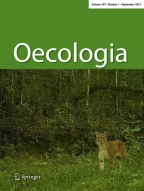Abstract
Hydraulic lift is the passive movement of water from roots into soil layers with lower water potential, while other parts of the root system in moister soil layers, usually at depth, are absorbing water. Here, we review the brief history of laboratory and field evidence supporting this phenomenon and discuss some of the consequences of this below-ground behavior for the ecology of plants. Hydraulic lift has been shown in a relatively small number of species (27 species of herbs, grasses, shrubs, and trees), but there is no fundamental reason why it should not be more common as long as active root systems are spanning a gradient in soil water potential (Ψs) and that the resistance to water loss from roots is low. While the majority of documented cases of hydraulic lift in the field are for semiarid and arid land species inhabiting desert and steppe environments, recent studies indicate that hydraulic lift is not restricted to these species or regions. Large quantities of water, amounting to an appreciable fraction of daily transpiration, are lifted at night. This temporary partial rehydration of upper soil layers provides a source of water, along with soil moisture deeper in the profile, for transpiration the following day and, under conditions of high atmospheric demand, can substantially facilitate water movement through the soil-plant-atmosphere system. Release of water into the upper soil layers has been shown to afford the opportunity for neighboring plants to utilize this source of water. Also, because soils tend to dry from the surface downward and nutrients are usually most plentiful in the upper soil layers, lifted water may provide moisture that facilitates favorable biogeochemical conditions for enhancing mineral nutrient availability, microbial processes, and the acquisition of nutrients by roots. Hydraulic lift may also prolong or enhance fine-root activity by keeping them hydrated. Such indirect benefits of hydraulic lift may have been the primary selective force in the evolution of this process. Alternatively, hydraulic lift may simply be the consequence of roots not possessing true rectifying properties (i.e., roots are leaky to water). Finally, the direction of water movement may also be downward or horizontal if the prevailing Ψs gradient so dictates, i.e., inverse, or lateral, hydraulic lift. Such downward movement through the root system may allow growth of roots in otherwise dry soil at depth, permitting the establishment of many phreatophytic species.
Similar content being viewed by others
Author information
Authors and Affiliations
Additional information
Received: 2 June 1997 / Accepted: 24 September 1997
Rights and permissions
About this article
Cite this article
Caldwell, M., Dawson, T. & Richards, J. Hydraulic lift: consequences of water efflux from the roots of plants. Oecologia 113, 151–161 (1998). https://doi.org/10.1007/s004420050363
Issue Date:
DOI: https://doi.org/10.1007/s004420050363
